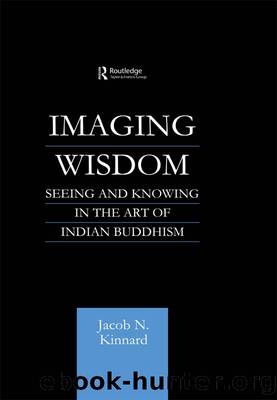Imaging Wisdom by Jacob N Kinnard

Author:Jacob N Kinnard [Kinnard, Jacob N]
Language: eng
Format: epub
ISBN: 9788120817937
Google: uzZM9ZK-R1QC
Publisher: Motilal Banarsidass Publ.
Published: 2001-01-15T03:37:58+00:00
Chapter Five
REPRESENTING
PRAJÃÄPÄRAMITÄ
A person will indeed know this: When the noble, perfectly enlightened TathÄgata was training in the way of the bodhisattva, he learned this PrajñÄpÄramitÄ, [and so] we too should learn it, thinking, âThis is our teacher."
AstasÄhasrikÄprajñÄpÄramitÄ1
I have argued in the last chapter that ÅÄkyamuni is from the very beginning intimately associated with prajñÄ, and that this association, furthermore, was also at play in even the earliest images of the Buddha. It is wisdom that ultimately enables him to attain enlightenment, that enables Gautama to triumph over Mara and to become the Buddha. And it is wisdom that is at the heart of the dharma that he first makes known at SÄrnÄth. With the rise of the MahÄyÄna, prajÃ±Ä moves to the center of Buddhist discursive and ritual practice as the perfection par excellence. I have also explored in the last chapter the ways in which - through the use of what I shall call âresonant iconographyâ - this abstract cognitive faculty is indirectly visually expressed, represented, and presented when the Buddha is sculpturally represented. I have thus argued that during the PÄla period, when prajÃ±Ä is very much at the center of Buddhist discourse and practice, to see an image of the Buddha was to see wisdom, since the essential quality of the Buddha is this prajÃ±Ä that leads him (and, ideally, the viewer of, or participant in, such an image) to enlightenment.
In this chapter, I explore the direct representation of prajÃ±Ä itself, specifically in the form of the deity PrajñÄpÄramitÄ, who first emerges in India sometime around the eighth century. I pay close attention here to the textual discourse on prajñÄpÄramitÄ, particularly that contained within the AstasÄhasrikÄprajñÄpÄramitÄ and related texts, since it is this discourse, I argue, that underlies and leads to the sculptural representation of what is frequently called in Western scholarship the âGoddess of Wisdom,â the âMother of the Buddhas,â even âMother Wisdom."
I have divided the present chapter into three main parts. First, I examine the textual discourse on the supremacy of the prajñÄpÄramitÄ as an object of veneration. An important component in this discourse is the ideological shift away from the veneration of the physical remains of the Buddha to the veneration of the prajñÄpÄramitÄ text itself. An essential component in this shift, in turn, is an amalgamation of the received conceptions of the rÅ«pa and dharmakÄyas; both become contained in a single object, the PrajñÄpÄramitÄ book.
Second, I will examine the essential rationale for this shift, a topic I have touched on in the last chapter: namely, the conception of the prajñÄpÄramitÄ as the source and origin of the Buddha's enlightenment, as the teacher of the TathÄgatas, as their âmother". Western scholars have frequently taken this discourse literally, and discussed PrajñÄpÄramitÄ as some sort of a mother goddess. I will, in this regard, examine in detail the specific passages that employ such âmother language,â and I will argue that in fact such interpretations -prajñÄpÄramitÄ as Mother Wisdom, the Mother of All Buddhas, etc. -is often
Download
This site does not store any files on its server. We only index and link to content provided by other sites. Please contact the content providers to delete copyright contents if any and email us, we'll remove relevant links or contents immediately.
Technical Art History by Jehane Ragai(451)
Art, Science, and the Natural World in the Ancient Mediterranean, 300 BC to AD 100 by JOSHUA J. THOMAS(406)
Graphic Culture by Lerner Jillian;(396)
The Slavic Myths by Noah Charney(366)
Pollak's Arm by Hans von Trotha(338)
Treasuring the Gaze by Hanneke Grootenboer(336)
Simply Artificial Intelligence by Dorling Kindersley(335)
Sketchbook Confidential: Secrets from the private sketches of over 40 master artists by Editors of North Light Books(333)
The Art of Portrait Drawing by Cuong i(329)
Drawing for the Soul by Zoë Ingram(326)
Drawing Landscapes by Barrington Barber(317)
Mountain Manâs Field Guide to Grammar by Gary Spina(310)
The Art of Painting Sea Life in Watercolor by Maury Aaseng Hailey E. Herrera Louise De Masi and Ronald Pratt(308)
Portrait of a Woman by Bridget Quinn(295)
Anatomy for the Artist by Jennifer Crouch(289)
A text-book of the history of painting by Van Dyke John Charles 1856-1932(287)
Preparing Dinosaurs by Wylie Caitlin Donahue;(279)
Botanical Illustration by Valerie Price(277)
Egyptian art by Jean Capart(276)
